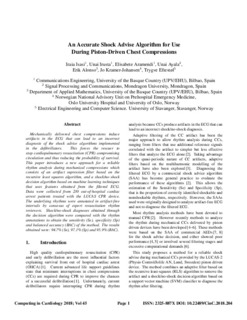| dc.rights.license | Attribution 4.0 International | * |
| dc.contributor.author | Ayala, Unai | |
| dc.contributor.other | Isasi, Iraia | |
| dc.contributor.other | Irusta, Unai | |
| dc.contributor.other | Aramendi, Elisabete | |
| dc.contributor.other | Alonso, Erik | |
| dc.contributor.other | Kramer-Johansen, Jo | |
| dc.contributor.other | Eftestøl, Trygve | |
| dc.date.accessioned | 2022-07-28T07:21:26Z | |
| dc.date.available | 2022-07-28T07:21:26Z | |
| dc.date.issued | 2018 | |
| dc.identifier.isbn | 9781728109589 | en |
| dc.identifier.issn | 2325-887X | en |
| dc.identifier.other | https://katalogoa.mondragon.edu/janium-bin/janium_login_opac.pl?find&ficha_no=153553 | en |
| dc.identifier.uri | https://hdl.handle.net/20.500.11984/5645 | |
| dc.description.abstract | Mechanically delivered chest compressions induce artifacts in the ECG that can lead to an incorrect diagnosis of the shock advice algorithms implemented in the defibrillators. This forces the rescuer to stop cardiopulmonary resuscitation (CPR) compromising circulation and thus reducing the probability of survival. This paper introduces a new approach for a reliable rhythm analysis during mechanical compressions which consists of an artifact supression filter based on the recursive least squares algorithm, and a shock/no-shock decision algorithm based on machine learning techniques that uses features obtained from the filtered ECG. Data were collected from 230 out-of-hospital cardiac arrest patients treated with the LUCAS CPR device. The underlying rhythms were annotated in artifact-free intervals by consesus of expert resuscitation rhythm reviewers. Shock/no-shock diagnoses obtained through the decision algorithm were compared with the rhythm annotations to obtain the sensitivity (Se), specificity (Sp) and balanced accuracy (BAC) of the method. The results obtained were: 94.7% (Se), 97.1% (Sp) and 95.9% (BAC). | en |
| dc.language.iso | eng | en |
| dc.publisher | IEEE | en |
| dc.rights | © 2018 The Authors | en |
| dc.rights.uri | http://creativecommons.org/licenses/by/4.0/ | * |
| dc.subject | Cardiopulmonary Resuscitation | en |
| dc.subject | Thorax | en |
| dc.subject | Compression depth | en |
| dc.title | An Accurate Shock Advise Algorithm for Use During Piston-Driven Chest Compressions | en |
| dcterms.accessRights | http://purl.org/coar/access_right/c_abf2 | en |
| dcterms.source | Computing in Cardiology Conference (CinC). Maastricht, Netherlands | en |
| local.contributor.group | Teoría de la señal y comunicaciones | es |
| local.description.peerreviewed | true | en |
| local.description.publicationfirstpage | 23 | en |
| local.description.publicationlastpage | 26 | en |
| local.identifier.doi | http://dx.doi.org/10.22489/CinC.2018.204 | en |
| local.contributor.otherinstitution | https://ror.org/000xsnr85 | eu |
| local.contributor.otherinstitution | https://ror.org/00j9c2840 | en |
| local.contributor.otherinstitution | https://ror.org/02qte9q33 | en |
| local.source.details | Vol.45, 23-26 September. IEEE, 2018 | en |
| oaire.format.mimetype | application/pdf | |
| oaire.file | $DSPACE\assetstore | |
| oaire.resourceType | http://purl.org/coar/resource_type/c_c94f | en |
| oaire.version | http://purl.org/coar/version/c_970fb48d4fbd8a85 | en |








